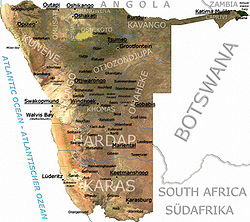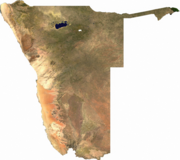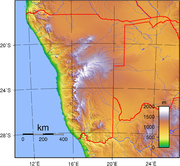
Geography of Namibia
About this schools Wikipedia selection
SOS Children has tried to make Wikipedia content more accessible by this schools selection. Click here for more information on SOS Children.
At 825,418 km2 (318,696 sq mi), Namibia is the world's thirty-fourth largest country (after Venezuela). After Mongolia, Namibia is the least densely populated country in the world (2.5 inhabitants per square kilometre (6.5 /sq mi)).
Climate
Desert; hot, dry; rainfall sparse and erratic
| Climate data for Namibia | |||||||||||||
|---|---|---|---|---|---|---|---|---|---|---|---|---|---|
| Month | Jan | Feb | Mar | Apr | May | Jun | Jul | Aug | Sep | Oct | Nov | Dec | Year |
| Source: ???? | |||||||||||||
Statistics
Location: Southern Africa, bordering the South Atlantic Ocean, between Angola and South Africa
Geographic coordinates: 22°00′S 17°00′E
Map references: Africa
Area:
total: 825 418 km²
land: 825 418 km²
water: 0 km²
Land boundaries:
total: 3 824 km
border countries: Angola 1 376 km, Botswana 1 360 km, South Africa 855 km, Zambia 233 km
Coastline: 1 572 km
Maritime claims:
contiguous zone: 24 nmi (44.4 km; 27.6 mi)
exclusive economic zone: 200 nmi (370.4 km; 230.2 mi)
territorial sea: 12 nmi (22.2 km; 13.8 mi)
Terrain: Mostly high plateau; Namib Desert along coast; Kalahari Desert in east. In the north near the border with Angola there is a flat area that has been designated by the World Wildlife Fund as part of the Angolan Mopane woodlands ecoregion.
Elevation extremes:
lowest point: Atlantic Ocean 0 m
highest point: Königstein 2 573 m
Natural resources: diamonds, copper, uranium, gold, lead, tin, lithium, cadmium, zinc, salt, vanadium, natural gas, hydropower, fish
note: suspected deposits of oil, coal, and iron ore
Land use:
arable land: 0.99% (1998 est.) 1% (1993 est.)
permanent crops: 0% (1998, 1993 est.)
permanent pastures: 46% (1993 est.)
forests and woodland: 22% (1993 est.)
other: 99.01 (1998 est.), 31% (1993 est.)
Irrigated land: 70 km² (1998 est.), 60 km² (1993 est.)
Natural hazards: prolonged periods of drought
Environment - current issues: very limited natural freshwater resources; desertification
Environment - international agreements:
party to: Antarctic-Marine Living Resources, Biodiversity, Climate Change, Desertification, Endangered Species, Hazardous Wastes, Law of the Sea, Ozone Layer Protection, Wetlands
signed, but not ratified: none of the selected agreements




